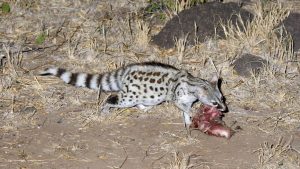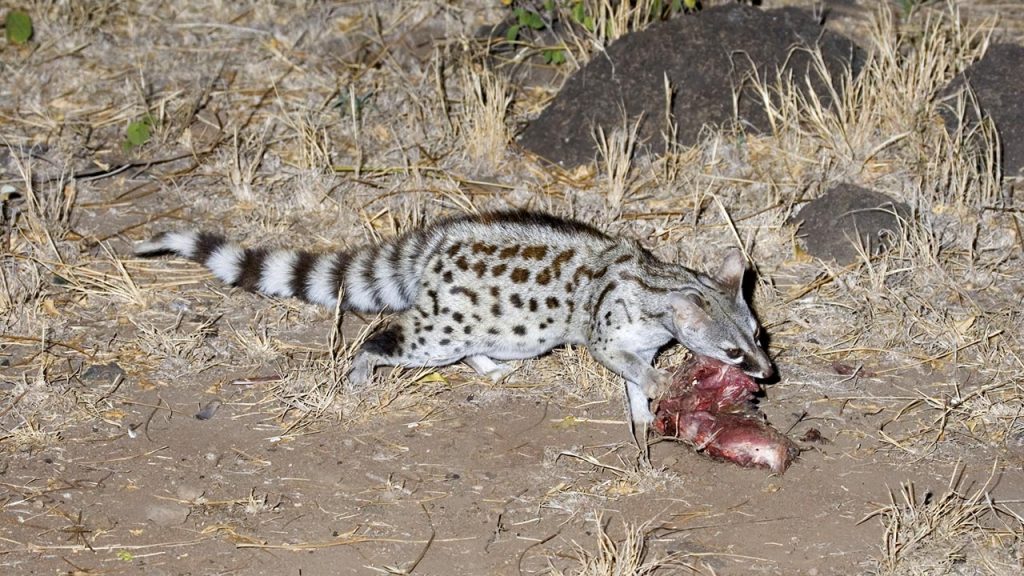Spotted Genets in East Africa
A genet has two common species, which are the large spotted genet and the small spotted genets seen when on a Ugandan wildlife safari in Queen Elizabeth National Park. They are members of the genus Genetta, which consists of 17 species of small African carnivores. Gents are long, lean carnivores that appear catlike with a tail, usually as long as the body. The large spotted genet has a smaller dorsal crest and high-set oval ears and is the most distributed of the two species, and all species have retractable claws adapted for climbing and catching prey.

Kits Genets
The courtship dance of genets’ brief but sinuous affair. The male follows behind the female as she lurks in the haphazard circles and patterns. After 70 days later, the female will seek a harrow suitable tree to give birth from. They give birth to about four genet kits, each weighing less than 100 grams. The genet kits’ eyes don’t open till after 10 days. They begin to eat solid food at six weeks but will start to hunt for their food at four months. To see spotted genets in East Africa, your best chances are in Uganda, particularly in areas of the Toro-Semuliki Wildlife Reserve and Queen Elizabeth National Park, where you can spot the large spotted genet and the smaller genet during night drives, these areas offer dense vegetation where genets love and are most likely to be found.
Habitat
These are found in Uganda that is Toro-Semuliki and Queen Elizabeth National Park, in areas with dense vegetation like forests and wooded areas near water sources. Genets are nocturnal, so night drives are the best way to see them. Toro-Semuliki Wildlife Reserve and Queen Elizabeth National Park in Uganda are excellent locations to spot genets. As the sun sets over the savannas and dense woodlands of East Africa, a nocturnal symmetry begins. The air re-echoes with the calls of night creatures, and the shadows come alive with the subtle movements of evasive begins. Among these nocturnal inhabitants is the spotted genet, a creature of grace and mystery.
Spotted genets are more active in the cover of darkness, so embarking on a nocturnal safari means stepping into a different world. Equipped with specialized lighting, the guides will lead you on an adventure unrevealing the secrets of East Africa nocturnal. One can see these predators at night as they terrorize other small animals like birds and reptiles in the trees and on the ground with their sharp needle-like teeth and a pounce to rival any African field.
Attractions in Queen Elizabeth National Park
Queen Elizabeth National Park is found in western Uganda’s Kasese district, and it is a seven-hour drive from Kampala through Mbarara to Queen Elizabeth National Park. By air, it takes about a one-hour flight from Entebbe to Kasese Mweya airstrip. Queen Elizabeth National Park has a lot to offer to visitors in terms of attractions, gorges, Kazinga channels, and activities. Queen Elizabeth’s unique combination of savannah, forests, and water bodies make adventures drawn to her.
Wildlife
In Queen Elizabeth National Park, wildlife here includes leopards, elephants, waterbucks, hippos, buffaloes, Uganda kobs, tree-climbing lions, spotted hyenas, jackals, over 600 bird species, black and white colobus monkeys, olive baboons, vervet monkeys, and mongoose.
Kyambura Gorge
Kyambura Gorge, known as the Valley of Apes as this gorge is a top destination for chimpanzee trekking in the far east of Queen Elizabeth National Park. The gorge is located in the heart of Queen Elizabeth National Park and is a haven for chimpanzees. This is due to its underlying thick vegetation and the rich tropical rainforest as a result of its position on the equator.
Kazinga channel
This is a freshwater body of 32km connecting Lake Edward to Lake George. The channel is home to a variety of wildlife close to you, like the school of hippos, crocodiles, African elephants, and over 100 water bird species. This is a famous area for wildlife as they gather to quench their thirst. The Kazinga channel boat cruise is a popular way of exploring the park. Two boat cruise operators, the Uganda Wildlife Authority and Mweya Safari Lodge, and it takes 2 hours. While on a boat cruise, you can see most of the wildlife, such as large concentrations of hippos, Nile crocodiles, water birds, and buffaloes.
Mweya peninsula
This peninsula is located in the Rwenzururu sub-region of the Kasese district. Mweya peninsula is situated on the northern bank of the Kazinga channel. More so, it is the most visited attraction within Queen Elizabeth National Park. The popularity of the Mweya Peninsula is due to the combination of its transport links via Mweya Airport, the availability of quality accommodation, and its rich biodiversity.

Activities in Queen Elizabeth National Park
When visiting Queen Elizabeth National Park, there are various activities to participate in, and they range from wildlife to birds to chimp tracking to nature walks and many more.
Game drives
These involve viewing the animals and getting up close to them in the comfort of your vehicle. Game drives in the Ishasha sector reward a lot with majestic mammals. Including, elephants, buffaloes, and Uganda kob, as it is a less populated part of the park with traffic vehicles, so this gives you a better view of the lions in the plains.
Mongoose tracking
The mongooses have large heads, small ears, and long tails as long as their body, with strong claws used to dig burrows. This activity takes about 3 hours during safaris in the park, and it takes place in the Peninsula area. The tracking takes place in the morning and also in the afternoon.
Bird watching
Queen Elizabeth National Park is the best destination for birding. It has over 400 bird species, due to its rich habitats. From its dense forests of Kyambura Gorge to the wetland habitats of Lake George and Lake Edward. Many aquatic bird species are found around Kazinga Channel, including the African Skimmer, African Fish Eagle, and Yellow-billed stork. Shoebill is sighted in the Ishasha sector on Lake Edward flats as it’s a swampy habitat, and seeing the shoebill is the crown jewel on many birding lists.
Chimpanzee tracking
There are two species of chimpanzees remaining in the wild. The common chimpanzee and the Pygmy chimpanzee. The common chimpanzee is larger, weighing up to 70 kilograms, and more aggressive with communities led by a dominant male. Pygmy chimpanzees are smaller and more peaceful, with communities led by female leaders, and live up to 30 years in the wild and 60 years in reserve.
Lion tracking
This is mainly done by researchers on lions with collars. They use radiation trackers to monitor the movements of the lions. This involves learning more about their habits of the wild in the natural plain of Kasenyi. Lion tracking at Queen Elizabeth National Park is a highly flocked activity by visitors. This activity involves tracking down lions with the help of the rangers and radio collars that are fastened around the necks of the lions.












